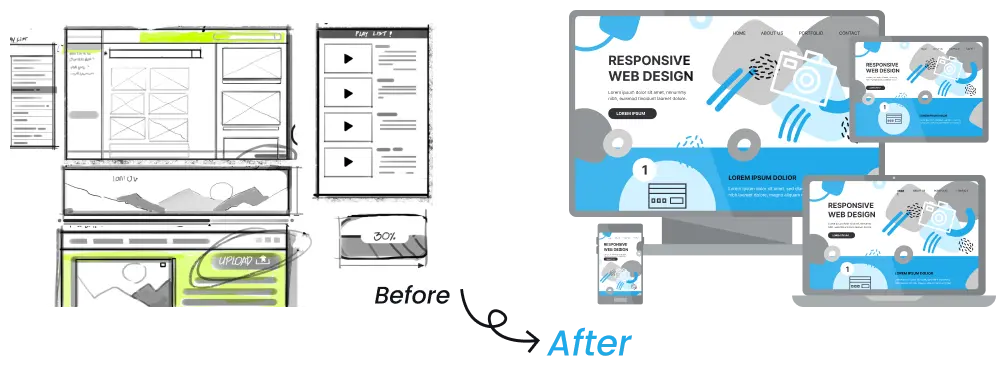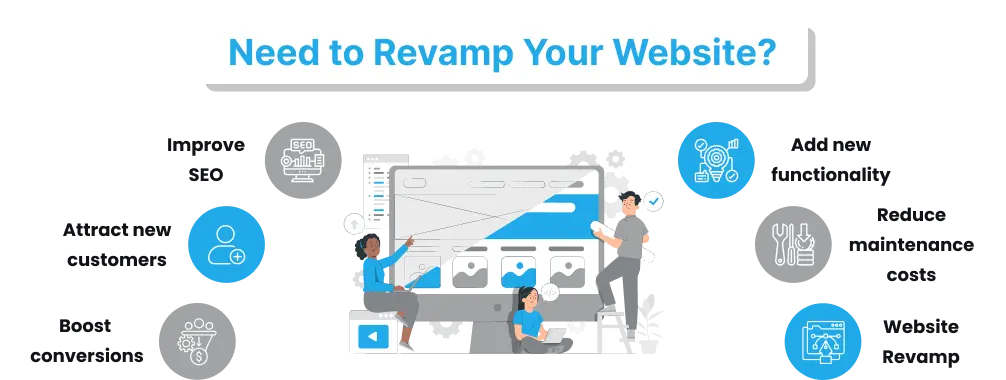Table of Contents
ToggleYour website is often the first touchpoint between your business and potential customers. It shapes that all-important first impression. An outdated, clunky website reflects poorly on your brand and drives visitors away. A modern, user-friendly site builds trust and engagement. This is why periodically revamping your website is so crucial.
Let’s explore what a website revamp entails, its key benefits, and when you should tackle this project. With some strategic planning and smart investment, a website revamp can yield tremendous dividends for your business.
What is Website Revamp?
A website revamp involves significantly updating the design, content, and technology of an existing website. Unlike routine maintenance, a revamp aims to transform the website’s overall aesthetic, functionality, and performance.
Typical changes and upgrades may include:
1. Modernizing outdated visual design.
2. Improving page navigation and site architecture.
3. Optimizing for mobile responsiveness.
4. Integrating new features like blogs, videos, etc.
5. Migrating to a new CMS platform.
6. Enhancing SEO elements for better rankings.
7. Streamlining user experience for higher conversions.
8. Implementing accessibility best practices.
9. Replacing dated content with new copy/imagery.
10. Adopting new brandings like colors, logos, and messaging.
11. Upgrading backend hosting infrastructure.
12. Adding e-commerce or membership capabilities.
The scope ranges from surface-level tweaks to complete website rebuilds. But all revamps share the goal of creating a superior user experience that achieves business goals.

Why Do You Need to Revamp Your Website?
Here are the top reasons you should make revamping your website a priority:
1. Boost conversions – An outdated, cluttered website drives visitors away rather than converting them. Revamping to simplify and streamline UX improves conversion rates.
2. Enhance brand image – A fresh, modern website aligns better with your current brand identity compared to an older site using obsolete branding.
3. Increase mobile friendliness – With more traffic from mobile devices, having a responsive site is now a must. Revamp to optimize for mobile.
4. Attract new customers – A revamp gives you a compelling platform to appeal to new demographics and business segments.
5. Improve SEO – Fixing technical SEO issues during a revamp can significantly improve your search rankings and organic traffic.
6. Add new functionality – Introduce features like e-commerce, video, blogs, etc. to provide more value to website visitors.
7. Reduce maintenance costs – Replacing outdated systems with new solutions lowers ongoing maintenance costs.
8. Website Revamp – In competitive markets, having a generic, dated website makes you forgettable. A unique, creatively executed revamp helps your business stand out.
9. Adopt new technologies – Implementing modern web technologies through a revamp keeps your website up-to-date with industry best practices.
10. Refresh your brand – Update colors, fonts, imagery, and other elements to ensure alignment with your current brand identity.

What happens if you don’t revamp your website?
Failing to periodically revamp your website comes with consequences:
1. Declining organic traffic as search engine rankings slowly drop
2. Loss of customers to competitors with superior website experiences
3. Missed opportunities and sales due to poor conversion optimization
4. Damage to brand reputation by projecting outdated branding
5. Rise in bounce rates and exit rates as visitors leave quickly
6. Limited reach as site fails to attract youth demographic
7. Loss of mobile traffic due to lack of responsiveness
8. Missed innovation opportunities from new technologies
9. Technical headaches as outdated systems become harder to maintain
10. Security vulnerabilities from aging software and platforms
11. Poor return on investment from aging software and platforms
The longer you put off a revamp, the more difficult and expensive catching up becomes down the road. Stay ahead of the curve with periodic revamps.
Results Don’t Lie!
Don’t take our word for it. Explore real client projects and discover the impact of our revamps.
Ready to transform your website like we did for Paid.com? Let’s talk now!

When Should You Revamp Your Website?
Some clear signs that it’s time for a website revamp include:
1. Your site wasn’t built responsively. Mobile optimization is now essential.
2. Site traffic and conversions have declined over the past 6-12 months.
3. Bounce rates have been steadily increasing recently.
4. Your brand identity has evolved, but the website still shows old branding.
5.Design trends have shifted noticeably and your site feels dated.
6. You want to target new demographics and your website doesn’t appeal to them.
7. Your business model has changed and you need new functionality like e-commerce.
8. Site maintenance and updates have become difficult and expensive.
9. Competitors have launched updated sites using newer technologies.
10. Google and other search rankings have slipped due to technical problems.
11. Load times, broken links, and errors have increased – signaling outdated systems.
While every business has unique needs, assessing the above points can help determine if the time is right for your next website to be revamped. As technology and trends continue evolving rapidly, periodic revamps are crucial for staying competitive.
How Much Does it Cost to Revamp a Website?
The cost of revamping your website depends heavily on various factors, making it difficult to suggest a specific figure. Therefore, there isn’t a single ‘perfect’ answer to this question. However, we can certainly tell you about the key factors that impact the cost, so you can get a better idea of what to expect.
Factors impacting cost include:
1. Amount of new design, copywriting, and content development.
2. Functional enhancements.
3. Responsiveness – converting the desktop site to a mobile responsive.
4. Number of pages a site includes.
5. Design complexity, custom illustrations, animations, etc.
7. Integration with other systems such as marketing automation, APIs, etc.
8. Whether you change CMS platforms or hosting infrastructure.
9. Level of custom development work required.
10. Accessibility and multi-language needs.
Investing in a quality revamp pays dividends through higher traffic, leads, sales, and brand perception. View it as a smart business investment, not an expense.

Is Your Website Costing You Your Customers? Revamp Your Brand with WebOsmotic Experts Now!
Conclusion
Maintaining a modern, optimized website through periodic revamps and updates is crucial for driving business growth today.
With technology and trends changing so rapidly, letting your website languish for too long can impede results and damage your brand reputation. Visitor expectations keep rising.
By revamping your website every 2-3 years, you ensure optimal user experience, conversions, SEO, and branding. Treat your website as a living, breathing extension of your brand rather than a static brochure. Keep it fresh.
The investment required is well worth the boost in traffic, leads, and sales. By partnering with a skilled web design and development agency, you get access to the latest web capabilities without the headaches of constant internal updates.
Approach your next website to revamp strategically. Map out business objectives, target audiences, pain points, and growth opportunities. Execute the revamp methodically with rigorous testing. The payoff for your business can be transformative.







